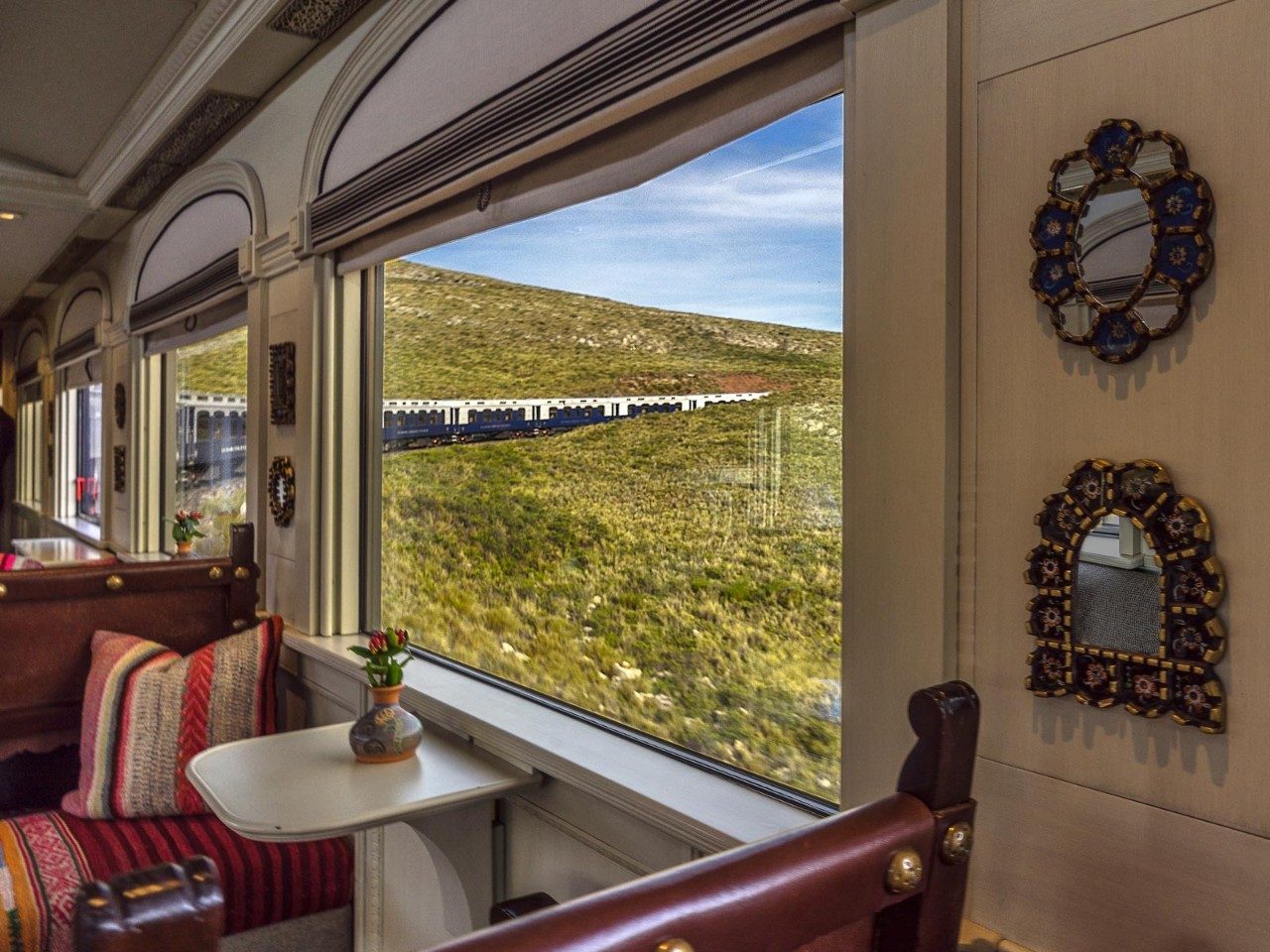A Romantic Train Ride Through the Peruvian Countryside

Leaving behind the fast pace of everyday life, Jonathan Franklin boards a luxury train for a leisurely three-day passage through the majestic Peruvian Andes.
Unzipping my travel bag, I remove a pair of Brazilian beach sandals and place them between hiking boots and polished leather shoes. Then I laugh. What does one pack for a three-day train trip that cuts through 4000- metre-high snowy mountains and visits sun-blasted floating islands made of squishy straw?
My wife and I are about to board the Andean Explorer, South America’s first deluxe overnight rail adventure. Emailed instructions from Belmond, the London-based operator of the train, have been clear on two fronts: formal wear is expected for cocktail hour and there’ll be little to no internet for the high mountain travel. Oxygen tanks, though, will be readily available.
Beyond that, we have no idea what to expect. I know next to nothing about the 500-kilometre route linking Cuzco to Arequipa, the two cities we’ll be visiting. Basic maths, however, suggests a trip conducted in slow motion. Calculated over the length of our journey, those 500 kilometres convert to roughly 10 kilometres per hour. It would be quicker to run briskly. When I check out the route in my atlas, there is nothing but empty territory encircled by volcanoes.
When departure day arrives, we load our deftly edited luggage onto the train and settle into the cabin that will be our home. Surrounded by 1920s-Pullman-style wood panelling, polished brass and convertible bunks beneath windows to the world, I feel like a character from Agatha Christie’s Murder on the Orient Express.
We hang our clothes in the tiny closet adjacent to the parquet-floored private bathroom.
Then, eager to explore, we wobble along narrow corridors with room for just one person to pass at a time. Near the end of the train, we find the lounge car, which has an atmosphere (if not an outlook) reminiscent of a 1925 Paris café.
As the bartender pours lemon-flavoured cocktails, I gaze out the window at the sea of grassland. Peru’s national drink, the Pisco Sour, is made from a grape brandy (pisco) shaken with eggwhite and scented with bitters. I’ve lived in South America for 21 years and I know my pisco so I pepper the bartender with questions. “You’d never get this flavour if you used a blender,” he says. “The ice is to cool the pisco, not dilute it. The bitters add a cloud of aroma to float inside the glass.”
The train glides on. Outside, there are no roads. No signs of electricity. We clack by entire valleys devoid of human settlement.
The bartender gets to work on a pair of Bloody Marys, an Aperol with champagne and a Margarita for the eclectic group that has now formed, including a 60-year-old executive from the Isle of Man who’s on a grown-up “gap year”, two retired journalists from Boston and a Colombian jeweller who shares tales from Paris Fashion Week with my wife.

Start planning now
Though the Andean Explorer’s executive chef, Diego Muñoz, is famed as one of Peru’s premier contemporary cooks, we’ve climbed above 4000 metres and I’m feeling too dizzy from the lack of oxygen to eat. I take a dip into the frigid mountain air then head to bed.
When I wake, the train has stopped on the shores of Lake Titicaca, the highest of the world’s great lakes. We walk to photograph the sunrise then a boat takes us to visit indigenous communities that live on floating islands fashioned from a three-metre-thick cushion of dried reeds. “When the families get into big arguments sometimes, they use this,” says our guide as he holds up a long blade. “They simply divide the island into ‘mine’ and ‘yours’ and saw it apart, each family drifting off on its own path.”
The teenage boys here still learn to knit and weave intricate hats and dresses. It’s the stitching and the finish, our guide explains, that has traditionally signified a worthy suitor.
Returning by boat, we board the train and rattle slowly out of the town of Puno, schoolchildren shouting from the playground and vendors hawking crates of avocados in the open-air market as we pass. A shepherd halts his donkey laden with metal milk flasks and waits. From the observation car, I snap photos and exchange smiles with locals. There’s not another tourist in sight.
As the train snakes its way back into the mountain passes, soothing Andean flute music beckons us to the lounge car. It’s cocktail hour, a semi-formal gathering.
In the bar, a singer and guitarist find a rhythmical back beat in the lilt of the wheels on the rails.
On the Andean Explorer, the day is broken into chunks of time – a few chapters read, an old tale of adventure retold in the lounge car or a silent moment of contemplation taken alone in the breeze. No internet, just the meditative expanse of Peru’s wild lands. This analog rhythm seems more natural. A nap is a nap, not time lost. The meals of regional Peruvian cuisine are savoured and leisurely not only because they’re delicious but also because there’s no checklist of things to do.
Routines of all sorts have been shattered here and when I disembark for a final guided tour – at a rural stop several hours outside Arequipa – I’m grateful to
be headed into a remote canyon. I’m not ready for ringing phones or traffic jams yet. I’ve disconnected. And I’ve been recharged. Images: Jamie Quiroz


